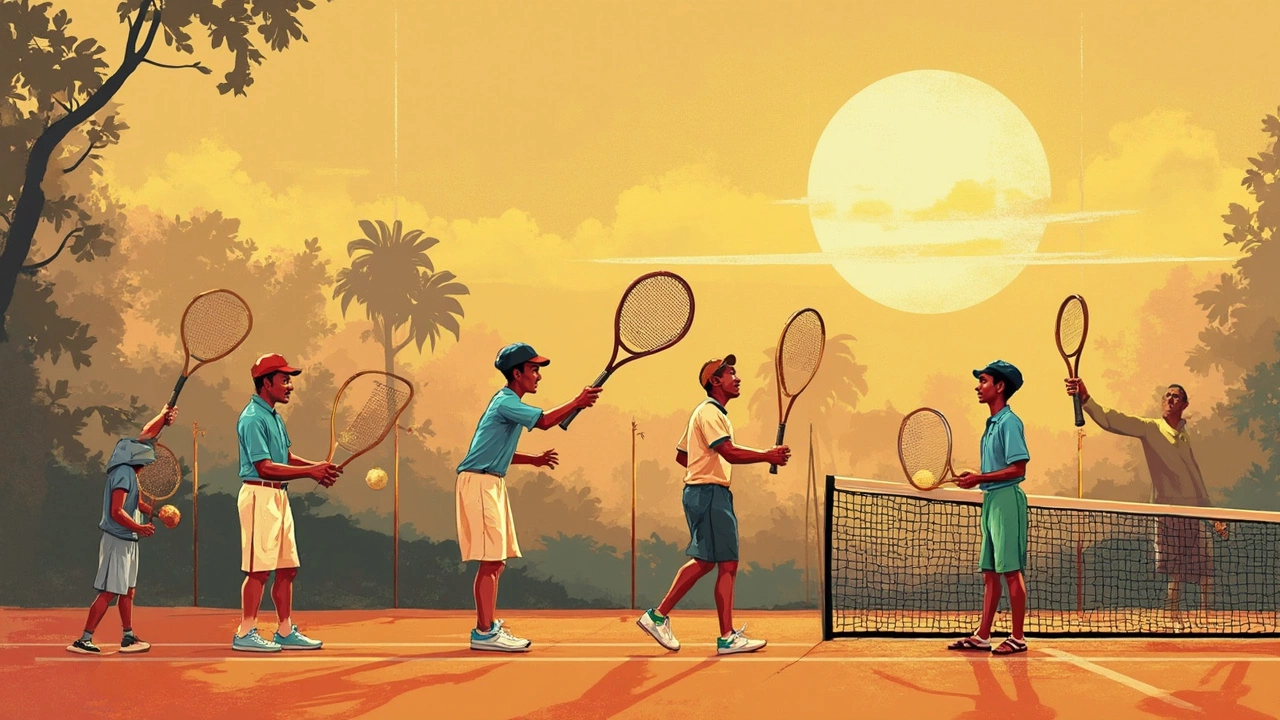Ever heard of a tennis match lasting longer than a workday? Try three days. The craziest thing is, it happened at Wimbledon, the most traditional tournament around. You’d expect quick grass-court games, but in 2010, John Isner and Nicolas Mahut broke all the records. Their match lasted 11 hours and 5 minutes, spread over three days. Insane, right?
Most matches never even sniff five hours. This one racked up 183 games. Both guys kept holding serve until the score looked like a phone number: 70–68 in the final set! This wasn’t just a battle of skill—it was two guys refusing to give up, shot after shot, despite cramping limbs and groaning crowds.
If you ever find yourself stuck in a match that just won’t end, think about what these two endured. Staying focused, eating snacks between games, and keeping your cool matter more than fancy footwork. There’s a reason tennis folks still talk about Isner-Mahut—it was more endurance test than sport. Want to know why it lasted forever and what the players did to survive? Let’s get into the details.
- The Marathon Match: Key Details
- Why Did It Last So Long?
- How the Players Survived
- Impact on Tennis Rules
- Lessons for Any Tennis Player
The Marathon Match: Key Details
The longest tennis match in history went down at Wimbledon in 2010, featuring John Isner from the US and Nicolas Mahut from France. This wasn’t just another epic game—it smashed every record out there for duration and games played.
The showdown started on June 22 and didn’t wrap up until June 24. In total, it lasted 11 hours and 5 minutes, covering three full days because of darkness. The fifth set alone ran for over eight hours—let that sink in. By the end, the scoreline stood at 6–4, 3–6, 6–7(7), 7–6(3), 70–68. That’s 183 total games, and just the last set had 138 games!
| Match Details | Value |
|---|---|
| Duration | 11 hours, 5 minutes |
| Dates played | June 22–24, 2010 |
| Total games | 183 |
| Final set score | 70–68 (Isner) |
| Aces (Isner/Mahut) | 113 / 103 |
For most matches, a couple of tie-breaks and a fifth set drag things out, but this one set a pace no one saw coming. Both players held serve over and over. Isner hit 113 aces—still a record for a single match—and Mahut fired 103. That’s more than double what you see in most marathon matches. Mahut actually hit more total winners (244), showing how tight it was the whole way through.
The official Wimbledon website said it best:
“It was pure grit. Neither player gave an inch over three days, turning Court 18 into a theater of endurance and willpower.”
There was even a plaque later set up at Court 18 to mark the historic match. Fans and players still swing by to check it out. If you’re ever there, look for John Isner and Nicolas Mahut’s names—etched for good reason.
Why Did It Last So Long?
The longest tennis match between John Isner and Nicolas Mahut wasn’t just a fluke. There were some solid reasons behind this insane marathon at Wimbledon 2010. First off, the crazy length happened because there was no fifth-set tiebreak at Wimbledon back then. The only way to win was to get ahead by two games, so the final set kept going... and going... and going.
Both Isner and Mahut had monster serves. Breaking serve was like trying to unlock a car with spaghetti—almost impossible. Nobody could get a real edge because they both blasted aces (Isner hit a whopping 113 in the match, Mahut 103). Here's how the serving stats really stacked up:
| Player | Aces | Double Faults | First Serve % |
|---|---|---|---|
| John Isner | 113 | 10 | 74% |
| Nicolas Mahut | 103 | 21 | 65% |
Neither guy was backing down mentally. Every time one had a shot to break, the other would hold. By the time the match went past 50-50 in the last set, it almost felt personal for both of them. Imagine the stubbornness and focus you’d need just to keep serving bombs for hours.
- No fifth set tiebreak (just endless games)
- Both had huge serves, kept holding
- Mental and physical toughness on another level
This all added up to something no one had seen before in Wimbledon or any other tennis tournament. If the rules hadn’t changed later, maybe we’d still be waiting for a winner today!

How the Players Survived
You’re probably wondering, how do you even last through a match like this? Both Isner and Mahut faced moments when they looked like they’d collapse. According to post-match chats, they both relied on a mix of stubbornness, constant fuel, and help from the folks around them. No one trains for the longest tennis match ever, but here’s what kept them going:
- Energizing with Food and Drinks: The players scarfed down bananas, energy gels, electrolyte drinks, and even took salt tablets to fend off cramps. Each break they got, trainers hustled out with snacks and drinks. Hydration was everything—without it, muscle cramps would have ended the match early.
- Mental Tricks: Both Isner and Mahut admitted their minds went numb at times. They started focusing on holding serve, not looking at the massive scoreboard. They leaned hard on routines: the same towel use, the same breathing, the same between-point habits.
- Physical Recovery: They got quick massages, stretching sessions, and cold spray from trainers during changeovers. After each day, ice baths and gentle stretching helped prep for the next round.
- Support from Coaches and Crowd: On the sidelines, coaches and family yelled encouragement. Even the Wimbledon crowd got behind them, knowing they were seeing tennis history unfold. Cheering and positive vibes really do help, especially when your legs feel like bricks.
Here’s a quick look at some basic match stats and what they went through physically:
| Player | Aces | Calories Burned (est.) | Changeovers |
|---|---|---|---|
| John Isner | 113 | ~10,000+ | 168 |
| Nicolas Mahut | 103 | ~10,000+ | 168 |
Imagine burning over 10,000 calories in a single match. By the final day, both players looked wrecked—their movements got slower, and they could barely get up after some points. Isner later said he could barely hold his racket by the end. Mahut needed physio help just standing up. So, surviving the longest tennis match is less about talent and more about grit, smart recovery, and stuffing your face with snacks between points.
Impact on Tennis Rules
The longest tennis match ever played sent shockwaves through the tennis world, but it didn’t just make headlines—it forced Wimbledon and other tournaments to rethink their rules. Before the Isner-Mahut marathon, matches at Wimbledon could, in theory, go on forever. There was no limit to the final set—it had to be won by two clear games. That’s exactly why their fifth set ballooned to 70–68.
Soon after, tournament officials realized this free-for-all wasn’t just tiring for players—it was rough on fans, schedules, and even broadcasters. No one wanted a repeat. So, in 2019, Wimbledon dropped their old system. Now, if the final set reaches 12-12, there’s a tiebreaker to decide the match. It’s quicker, fairer, and keeps super-long matches from hijacking the schedule.
The French Open tried to hold out, but in 2022, they finally added a tiebreak in the deciding set too. The US Open always had one. Even the Australian Open updated their format. So that wild match between John Isner and Nicolas Mahut pretty much forced Grand Slams everywhere to put in guardrails to prevent another never-ending battle.
- Wimbledon final set tiebreak now kicks in at 12-12.
- All four Grand Slams have deciding-set tiebreaks with slight variations.
- Long matches are still possible, but nothing like 11 hours.
Check out how the Grand Slam tiebreak rules stack up:
| Tournament | Final Set Tiebreak Rule (as of 2024) |
|---|---|
| Wimbledon | Tiebreak at 12-12 in final set |
| US Open | Tiebreak at 6-6 in final set |
| French Open | Tiebreak at 6-6 in final set |
| Australian Open | 10-point tiebreak at 6-6 in final set |
So, if you’re keeping track of tennis records, chances are you’ll never see another Isner-Mahut marathon. The rules have changed, and honestly, for the better. Players can focus on tennis instead of worrying about whether they’ll need a nap between serves.

Lessons for Any Tennis Player
If you think you’ve had a rough time on court, just imagine playing for 11 hours straight, like in the longest tennis match. That makes regular club matches seem like a breeze. Isner and Mahut didn’t just rely on talent—they used smart habits and hardcore routines. Here’s what stood out most and what everyday players can steal from their experience:
- Prioritize Recovery: Both guys iced their knees, stretched between days, and grabbed quick naps. Don’t skip your recovery. Even after shorter matches, your body needs time to bounce back. A simple ice pack and some stretching go a long way.
- Fuel Matters: During breaks, they scarfed down bananas, energy bars, and drank electrolyte drinks, not just water. Having the right snacks nearby helps maintain focus and keeps you from crashing mid-match.
- Mental Grit: Isner later said he focused on just "winning the next point." In long battles, worrying about the scoreboard drains energy. Stay present and handle one serve or return at a time.
- Stick to Routines: Isner and Mahut repeated their service preps and rituals, even when exhausted. Simple routines offer comfort and help keep nerves steady. Find a serving or returning habit that works for you, and stick to it under pressure.
- Know the Rules: The epic Isner–Mahut moment helped introduce final-set tiebreaks at majors, including Wimbledon. Know your tournament’s rules. It might save you a whole lot of headaches (and hours) on court.
Here’s a quick look at how that wild match stacks up against a normal pro contest:
| Match | Duration | Sets | Games |
|---|---|---|---|
| Isner vs. Mahut (2010 Wimbledon) | 11 hours 5 minutes | 5 | 183 |
| Average Pro 5-set Match | 2.5–3.5 hours | 5 | 40–60 |
The next time you’re tired during a tough set, remember the Isner–Mahut showdown. Play smart, stay fueled, and break the match into bite-sized moments. No one’s expecting you to beat the longest tennis match record, but these lessons are gold even in local leagues.

